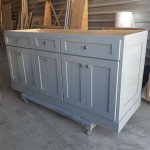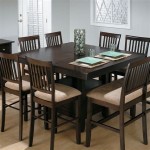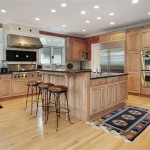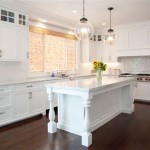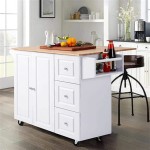Kitchen White Cabinets Wood Floor: A Timeless Combination
The pairing of white kitchen cabinets and wood flooring represents a classic design choice that transcends fleeting trends. This combination offers a versatile backdrop for various design styles, from traditional to contemporary, and provides a sense of warmth and brightness to the heart of the home.
White cabinets contribute significantly to a kitchen's perceived spaciousness. They reflect natural and artificial light, making even smaller kitchens appear larger and airier. This characteristic makes white cabinetry an especially appealing option for kitchens with limited natural light or compact layouts. The neutral backdrop of white also allows for greater flexibility in incorporating color accents through accessories, backsplashes, and countertops.
Wood flooring complements white cabinetry by introducing natural texture and warmth. The inherent variations in wood grain and color add depth and visual interest, preventing the all-white look from feeling sterile or monotonous. Wood flooring also offers durability and longevity, standing up well to the demands of a busy kitchen environment. It is a relatively easy material to maintain and can be refinished to restore its original beauty over time.
Several factors should be considered when selecting wood flooring to pair with white kitchen cabinets. The species of wood plays a crucial role in the overall aesthetic. Oak, known for its prominent grain and durability, adds a rustic or traditional touch. Maple, with its smoother grain and lighter tones, lends a more contemporary feel. Hickory offers a dramatic, high-contrast look with its varied grain patterns and color variations. Other popular choices include cherry, walnut, and pine, each with its unique characteristics.
The color of the wood flooring also significantly impacts the overall design. Light wood floors, such as white oak or ash, create a bright and airy atmosphere, enhancing the expansive effect of white cabinets. Medium-toned woods, like maple or hickory, offer a balanced look that bridges the gap between light and dark. Dark wood floors, such as walnut or mahogany, create a dramatic contrast with white cabinets, adding a touch of sophistication and grounding the space.
The finish of the wood flooring influences both its appearance and durability. Surface finishes protect the wood from scratches, dents, and moisture damage. A matte finish offers a natural, understated look, minimizing glare and showcasing the wood's natural texture. A satin finish provides a subtle sheen, adding a touch of elegance while still maintaining a relatively natural appearance. A gloss finish creates a highly reflective surface, maximizing light reflection and adding a touch of formality to the space.
The undertones of the white cabinets and wood flooring should be considered for a cohesive look. White cabinets can range from cool, bluish whites to warm, creamy whites. Similarly, wood flooring can have undertones of red, yellow, or brown. Pairing warm whites with warm-toned woods, or cool whites with cool-toned woods, creates a harmonious and balanced aesthetic.
Integrating other design elements with white cabinets and wood flooring can further enhance the overall aesthetic. Countertops offer an opportunity to introduce additional color and texture. Quartz, granite, and marble countertops provide a sophisticated look, while butcher block countertops offer a warm and rustic feel. The backsplash can be used to add a pop of color, pattern, or texture. Subway tile, mosaic tile, and glass tile are popular choices that complement both white cabinets and wood flooring.
Lighting plays a critical role in showcasing the beauty of white cabinets and wood flooring. Natural light should be maximized whenever possible. Layered lighting, incorporating ambient, task, and accent lighting, can create a warm and inviting atmosphere. Under-cabinet lighting can enhance the functionality of the workspace, while pendant lights over an island can add a touch of style.
Accessorizing the space with rugs, artwork, and decorative items can further personalize the kitchen and tie the design together. Rugs can define different areas within the kitchen and add warmth and texture. Artwork can introduce color and personality. Decorative items, such as plants, vases, and bowls, can add visual interest and create a welcoming atmosphere.
Ultimately, the combination of white kitchen cabinets and wood flooring provides a versatile and timeless foundation for a wide range of design styles. By carefully considering the species, color, and finish of the wood flooring, along with the undertones of the white cabinets and the integration of other design elements, homeowners can create a kitchen that is both beautiful and functional, reflecting their personal style and meeting their practical needs.

White Kitchen And Wood Floors

Should Your Kitchen Cabinets Match Flooring

45 Luxurious Kitchens With White Cabinets Ultimate Guide

White Kitchen Cabinet Design Guide Lily Ann Cabinets

13 Ideas For Upgrading Your Kitchen Floors Extra Space Storage

Can You Have White Cabinets With Espresso Hardwood Floors

Kitchen Interior With White Cabinets Yellow Walls And Wood Floor Stock Photo Iriana88w 121788116

White Kitchen Cabinet Design Guide Lily Ann Cabinets

45 Luxurious Kitchens With White Cabinets Ultimate Guide

White Kitchen With Caramel Stained Wood Floors Transitional

